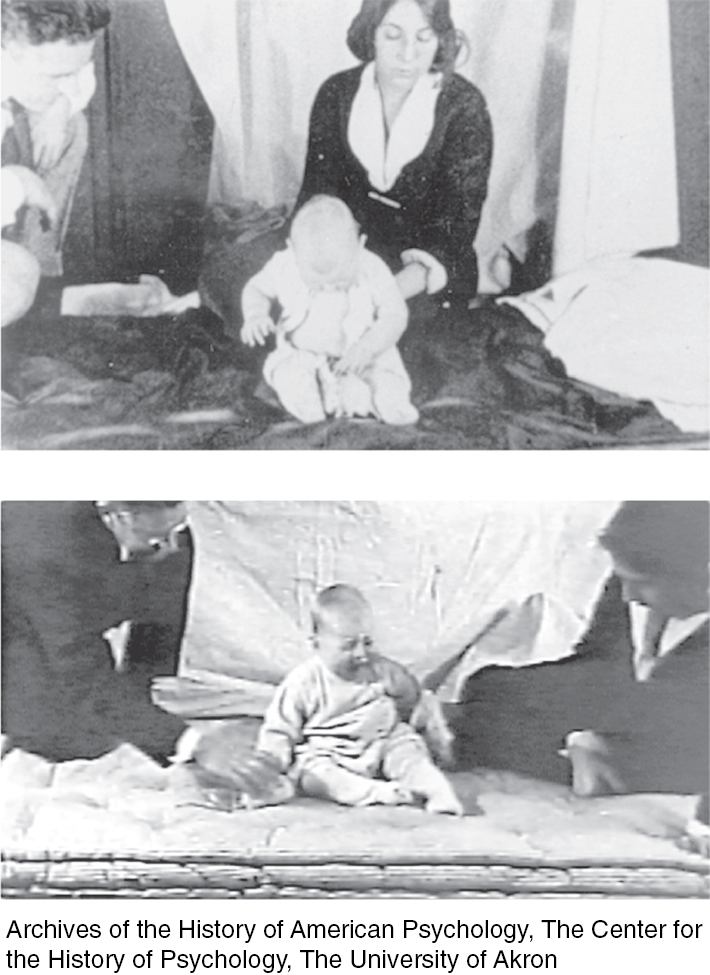19.2 Classical Conditioning
19-
classical conditioning a type of learning in which one learns to link two or more stimuli and anticipate events.
For many people, the name Ivan Pavlov (1849–
Pavlov’s work laid the foundation for many of psychologist John B. Watson’s ideas. In searching for laws underlying learning, Watson (1913) urged his colleagues to discard reference to inner thoughts, feelings, and motives. The science of psychology should instead study how organisms respond to stimuli in their environments, said Watson: “Its theoretical goal is the prediction and control of behavior. Introspection forms no essential part of its methods.” Simply said, psychology should be an objective science based on observable behavior.
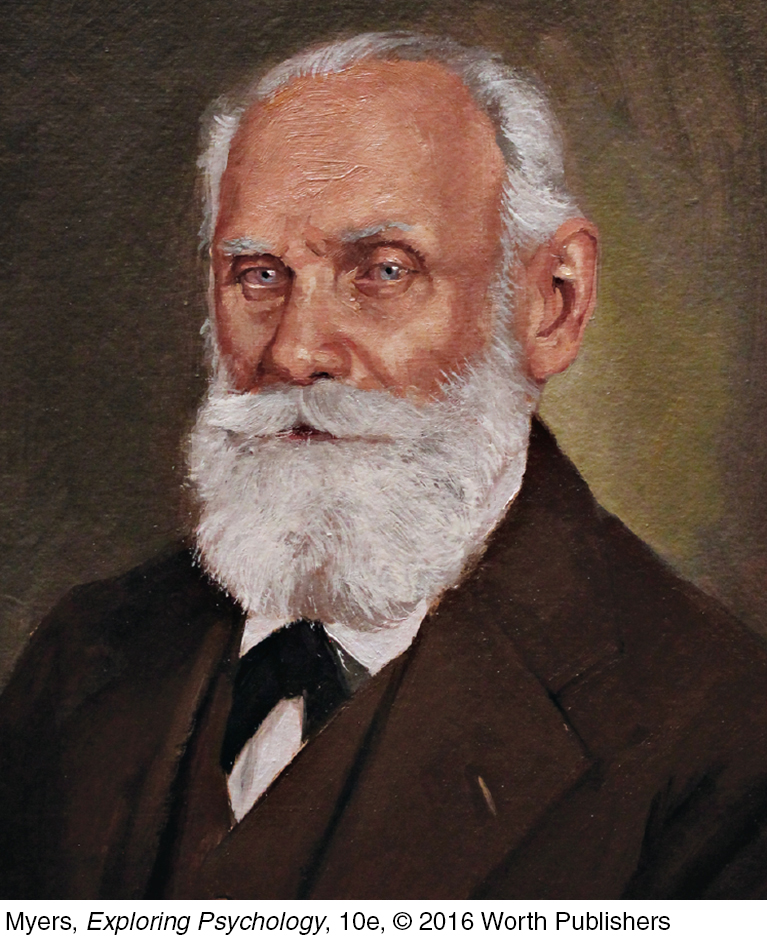
behaviorism the view that psychology (1) should be an objective science that (2) studies behavior without reference to mental processes. Most research psychologists today agree with (1) but not with (2).
This view, which Watson called behaviorism, influenced North American psychology during the first half of the twentieth century. Pavlov and Watson shared both a disdain for “mentalistic” concepts (such as consciousness) and a belief that the basic laws of learning were the same for all animals—
Pavlov’s Experiments
19-
Pavlov was driven by a lifelong passion for research. After setting aside his initial plan to follow his father into the Russian Orthodox priesthood, Pavlov received a medical degree at age 33 and spent the next two decades studying the digestive system. This work earned him, in 1904, Russia’s first Nobel Prize. But his novel experiments on learning, which consumed the last three decades of his life, earned this feisty scientist his place in history.
Pavlov’s new direction came when his creative mind seized on an incidental observation: Without fail, putting food in a dog’s mouth caused the animal to salivate. Moreover, the dog began salivating not only at the taste of the food, but also at the mere sight of the food, or the food dish, or the person delivering the food, or even at the sound of that person’s approaching footsteps. At first, Pavlov considered these “psychic secretions” an annoyance—
neutral stimulus (NS) in classical conditioning, a stimulus that elicits no response before conditioning.
Pavlov and his assistants tried to imagine what the dog was thinking and feeling as it drooled in anticipation of the food. This only led them into fruitless debates. So, to explore the phenomenon more objectively, they experimented. To eliminate other possible influences, they isolated the dog in a small room, secured it in a harness, and attached a device to divert its saliva to a measuring instrument (FIGURE 19.3). From the next room, they presented food—
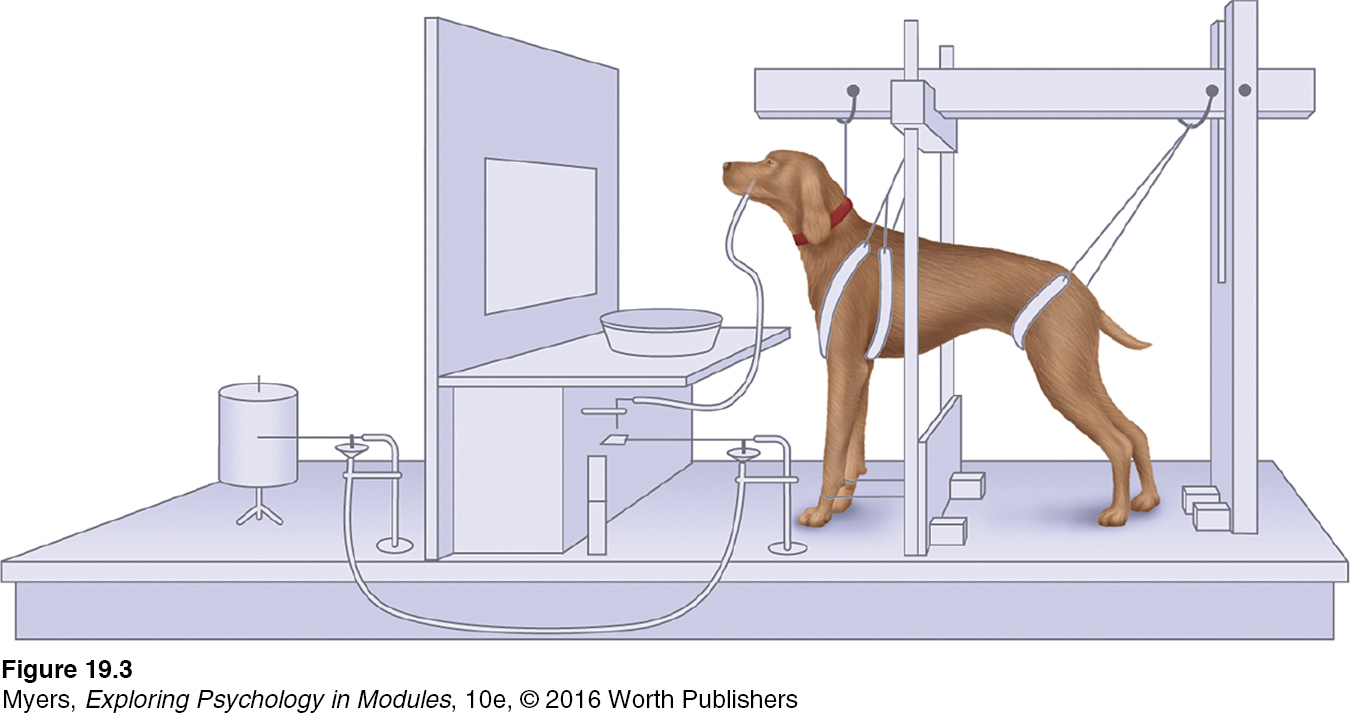
The answers proved to be Yes and Yes. Just before placing food in the dog’s mouth to produce salivation, Pavlov sounded a tone. After several pairings of tone and food, the dog, now anticipating the meat powder, began salivating to the tone alone. In later experiments, a buzzer1, a light, a touch on the leg, even the sight of a circle set off the drooling. (This procedure works with people, too. When hungry young Londoners viewed abstract figures before smelling peanut butter or vanilla, their brain soon responded in anticipation to the abstract images alone [Gottfried et al., 2003].)
unconditioned response (UR) in classical conditioning, an unlearned, naturally occurring response (such as salivation) to an unconditioned stimulus (US) (such as food in the mouth).
unconditioned stimulus (US) in classical conditioning, a stimulus that unconditionally—
A dog does not learn to salivate in response to food in its mouth. Rather, food in the mouth automatically, unconditionally, triggers a dog’s salivary reflex (FIGURE 19.4). Thus, Pavlov called the drooling an unconditioned response (UR). And he called the food an unconditioned stimulus (US).
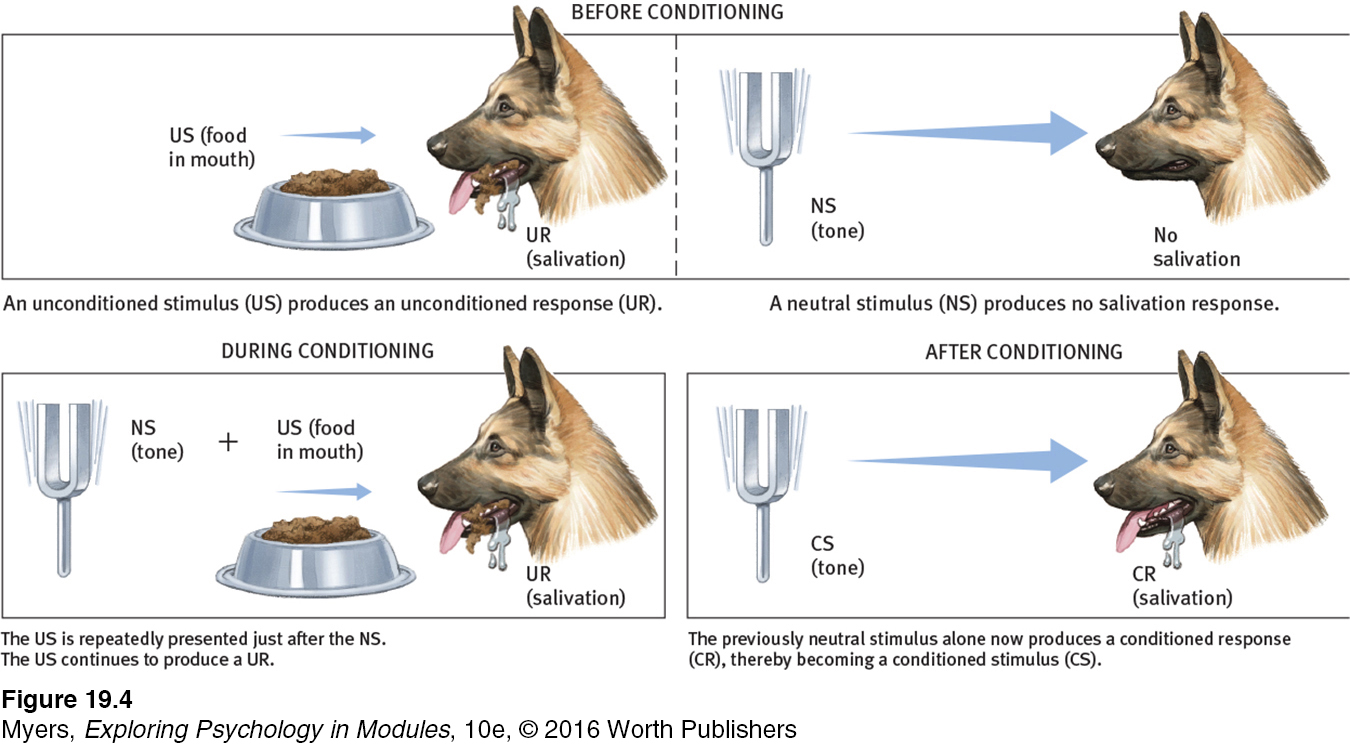
conditioned response (CR) in classical conditioning, a learned response to a previously neutral (but now conditioned) stimulus (CS).
conditioned stimulus (CS) in classical conditioning, an originally irrelevant stimulus that, after association with an unconditioned stimulus (US), comes to trigger a conditioned response (CR).
Salivation in response to the tone, however, is learned. It is conditional upon the dog’s associating the tone with the food. Thus, we call this response the conditioned response (CR). The stimulus that used to be neutral (in this case, a previously meaningless tone that now triggers salivation) is the conditioned stimulus (CS). Distinguishing these two kinds of stimuli and responses is easy: Conditioned = learned; unconditioned = unlearned.
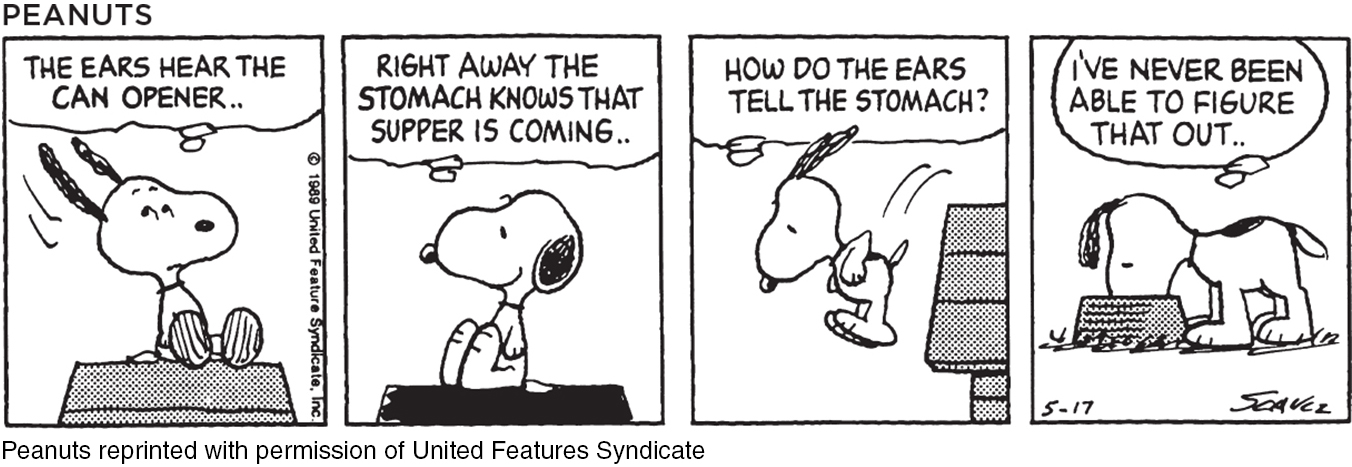
If Pavlov’s demonstration of associative learning was so simple, what did he do for the next three decades? What discoveries did his research factory publish in his 532 papers on salivary conditioning (Windholz, 1997)? He and his associates explored five major conditioning processes: acquisition, extinction, spontaneous recovery, generalization, and discrimination.
RETRIEVE IT
Question
An experimenter sounds a tone just before delivering an air puff to your blinking eye. After several repetitions, you blink to the tone alone. What is the NS? The US? The UR? The CS? The CR?
ACQUISITION
19-
acquisition in classical conditioning, the initial stage, when one links a neutral stimulus and an unconditioned stimulus so that the neutral stimulus begins triggering the conditioned response. In operant conditioning, the strengthening of a reinforced response.
Acquisition is the initial learning of an association. Pavlov and his associates wondered: How much time should elapse between presenting the NS (the tone, the light, the touch) and the US (the food)? In most cases, not much—
What do you suppose would happen if the food (US) appeared before the tone (NS) rather than after? Would conditioning occur? Not likely. With but a few exceptions, conditioning doesn’t happen when the NS follows the US. Remember, classical conditioning is biologically adaptive because it helps humans and other animals prepare for good or bad events. To Pavlov’s dogs, the originally neutral tone became a CS after signaling an important biological event—
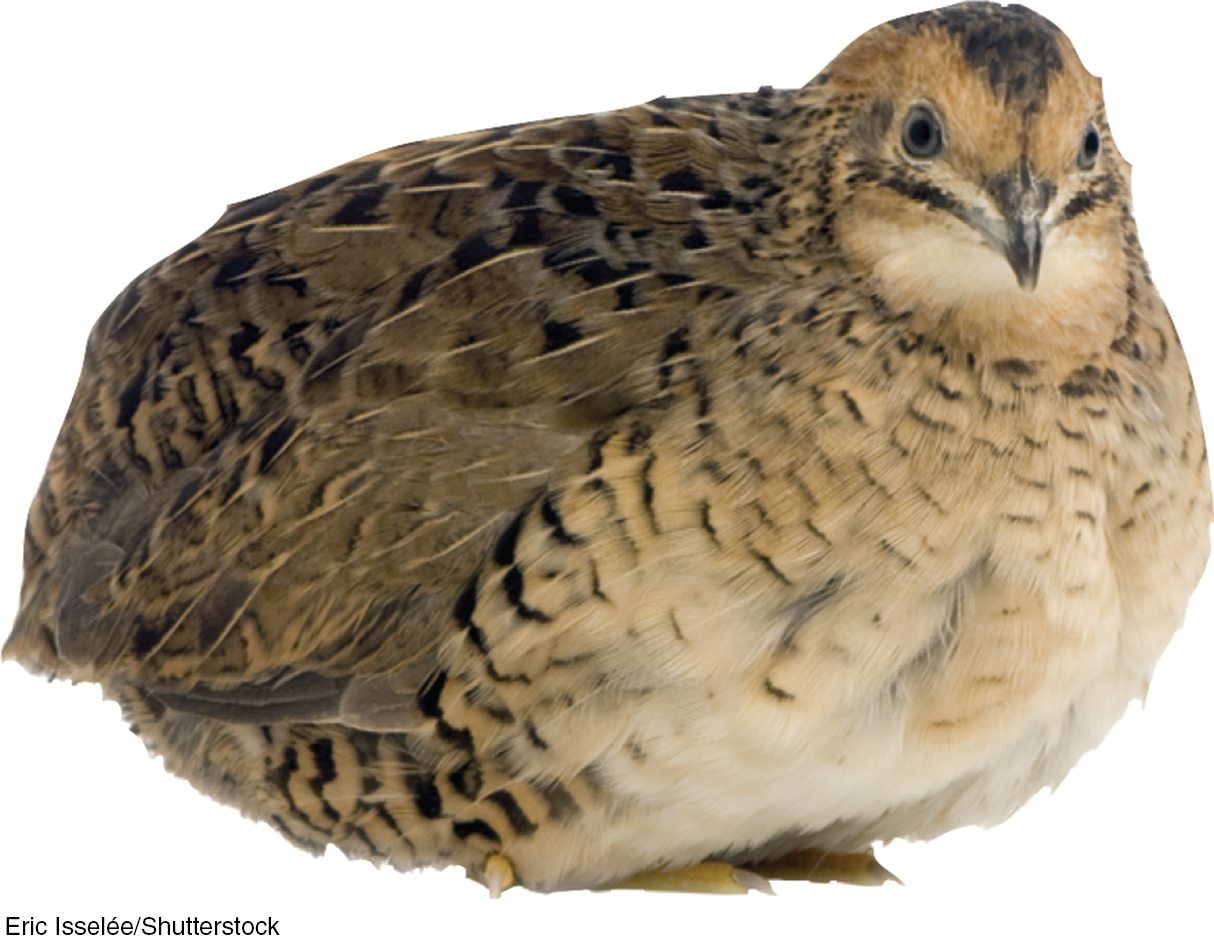
More recent research on male Japanese quail shows how a CS can signal another important biological event (Domjan, 1992, 1994, 2005). Just before presenting a sexually approachable female quail, the researchers turned on a red light. Over time, as the red light continued to herald the female’s arrival, the light caused the male quail to become excited. They developed a preference for their cage’s red light district, and when a female appeared, they mated with her more quickly and released more semen and sperm (Matthews et al., 2007). This capacity for classical conditioning gives the quail a reproductive edge.
In humans, too, objects, smells, and sights associated with sexual pleasure—
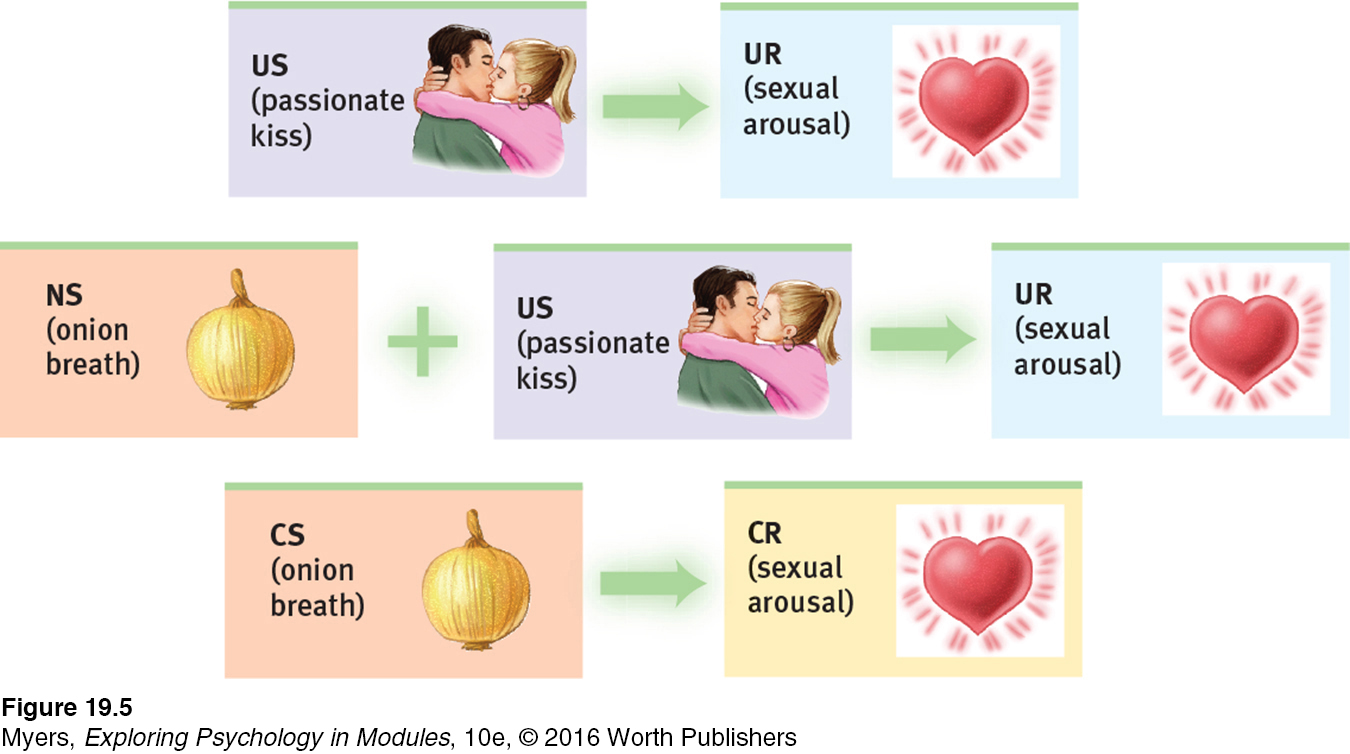
Remember:
NS = Neutral Stimulus
US = Unconditioned Stimulus
UR = Unconditioned Response
CS = Conditioned Stimulus
CR = Conditioned Response
extinction the diminishing of a conditioned response; occurs in classical conditioning when an unconditioned stimulus (US) does not follow a conditioned stimulus (CS); occurs in operant conditioning when a response is no longer reinforced.
spontaneous recovery the reappearance, after a pause, of an extinguished conditioned response.
RETRIEVE IT
Question
If the aroma of a baking cake sets your mouth to watering, what is the US? The CS? The CR?
EXTINCTION AND SPONTANEOUS RECOVERY What would happen, Pavlov wondered, if after conditioning, the CS occurred repeatedly without the US? If the tone sounded again and again, but no food appeared, would the tone still trigger salivation? The answer was mixed. The dogs salivated less and less, a reaction known as extinction, which is the diminished responding that occurs when the CS (tone) no longer signals an impending US (food). But a different picture emerged when Pavlov allowed several hours to elapse before sounding the tone again. After the delay, the dogs would again begin salivating to the tone (FIGURE 19.6). This spontaneous recovery—the reappearance of a (weakened) CR after a pause—
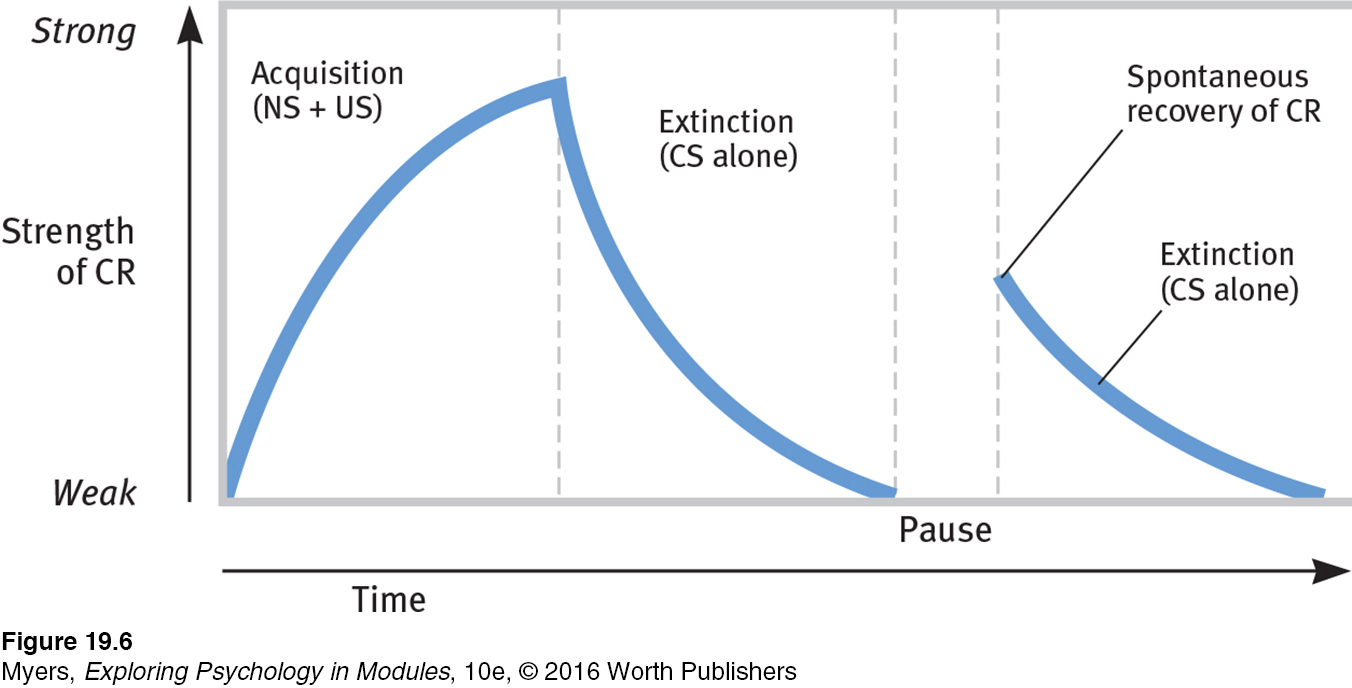
RETRIEVE IT
Question
The first step of classical conditioning, when an NS becomes a CS, is called . When a US no longer follows the CS, and the CR becomes weakened, this is called .
generalization the tendency, once a response has been conditioned, for stimuli similar to the conditioned stimulus to elicit similar responses.
GENERALIZATION Pavlov and his students noticed that a dog conditioned to the sound of one tone also responded somewhat to the sound of a new and different tone. Likewise, a dog conditioned to salivate when rubbed would also drool a bit when scratched (Windholz, 1989) or when touched on a different body part (FIGURE 19.7 below). This tendency to respond to stimuli similar to the CS is called generalization.
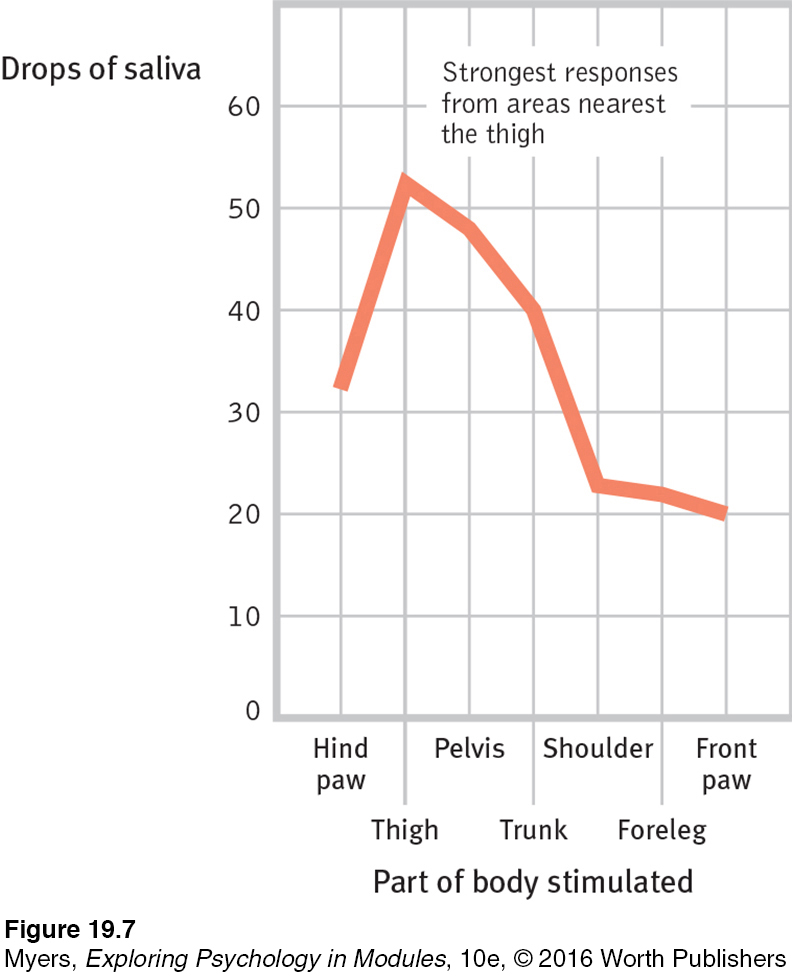
Generalization can be adaptive, as when toddlers taught to fear moving cars also become afraid of moving trucks and motorcycles. And generalized fears can linger. One Argentine writer who underwent torture recounted recoiling with fear years later at the sight of black shoes—
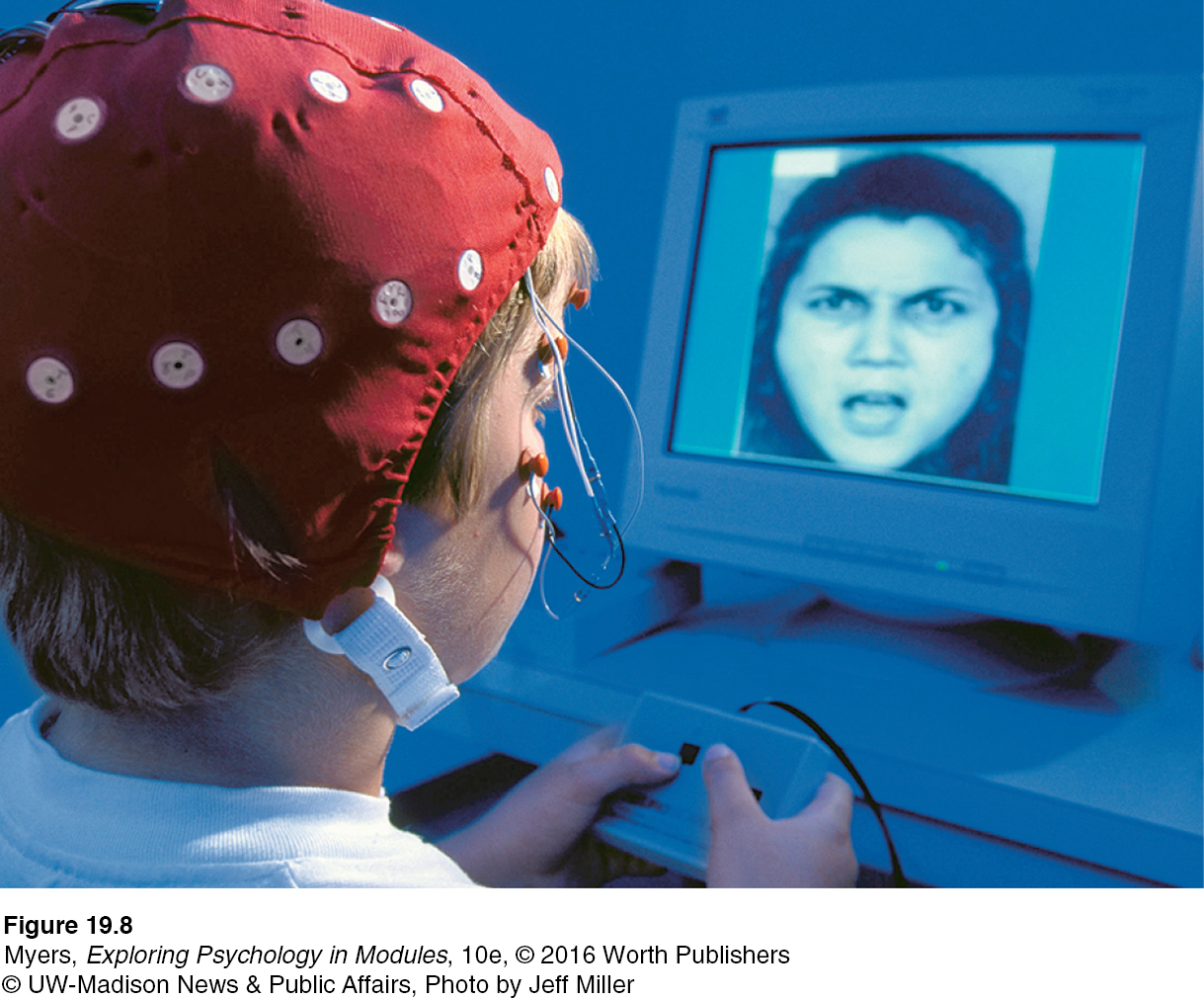
Stimuli similar to naturally disgusting objects will, by association, also evoke some disgust, as otherwise desirable fudge did when shaped to resemble dog feces (Rozin et al., 1986). Ditto when sewage gets recycled as utterly pure drinking water (Rozin et al., 2015). Toilet → tap = yuck. In these human examples, people’s emotional reactions to one stimulus have generalized to similar stimuli.
RETRIEVE IT
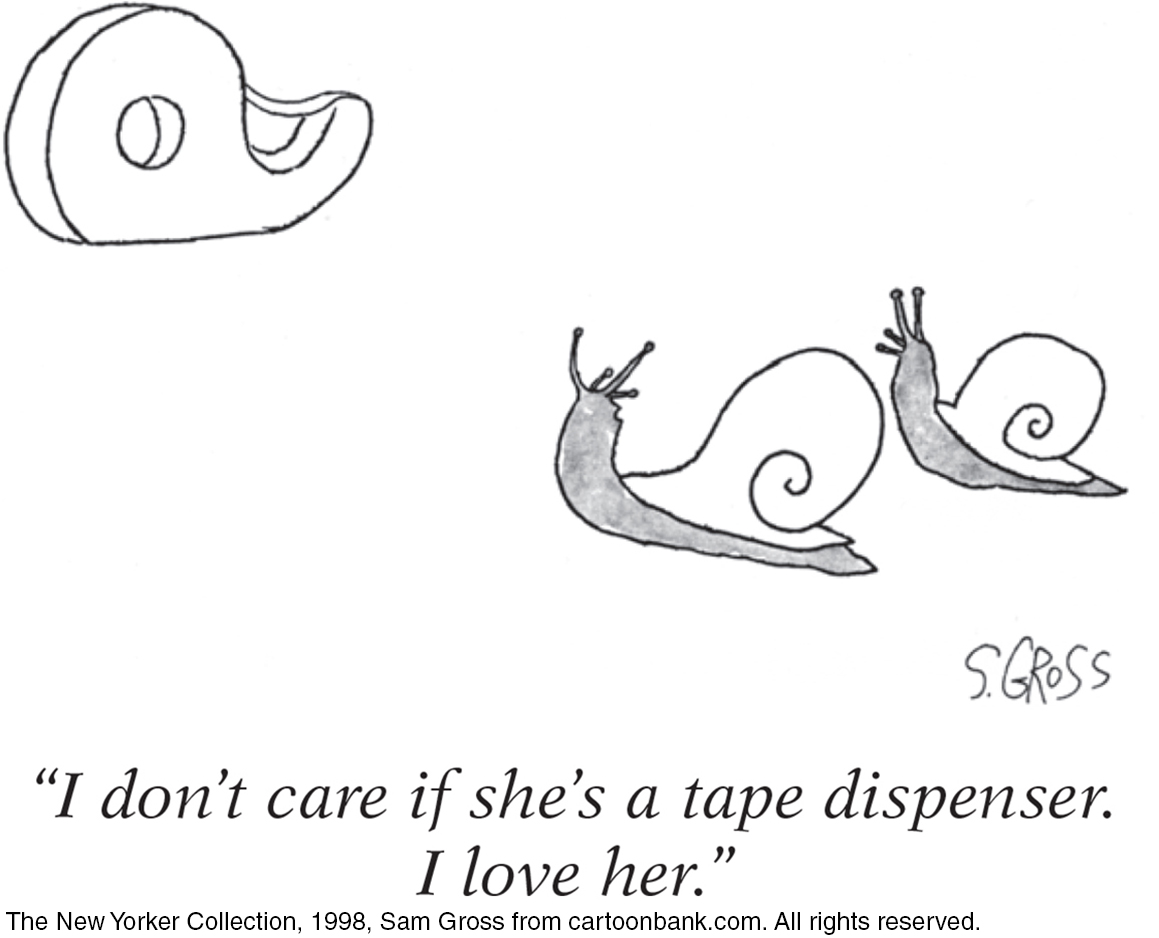
Question
What conditioning principle is influencing the snail's affections?
discrimination in classical conditioning, the learned ability to distinguish between a conditioned stimulus and stimuli that do not signal an unconditioned stimulus.
DISCRIMINATION Pavlov’s dogs also learned to respond to the sound of a particular tone and not to other tones. This learned ability to distinguish between a conditioned stimulus (which predicts the US) and other irrelevant stimuli is called discrimination. Being able to recognize differences is adaptive. Slightly different stimuli can be followed by vastly different consequences. Facing a guard dog, your heart may race; facing a guide dog, it probably will not.
Pavlov’s Legacy
19-
What remains today of Pavlov’s ideas? A great deal. Most psychologists now agree that classical conditioning is a basic form of learning. Judged with today’s knowledge of the interplay of our biology, psychology, and social-
 To review Pavlov’s classic work and to play the role of experimenter in classical conditioning research, visit LaunchPad’s PsychSim 6: Classical Conditioning. See also a 3-
To review Pavlov’s classic work and to play the role of experimenter in classical conditioning research, visit LaunchPad’s PsychSim 6: Classical Conditioning. See also a 3-
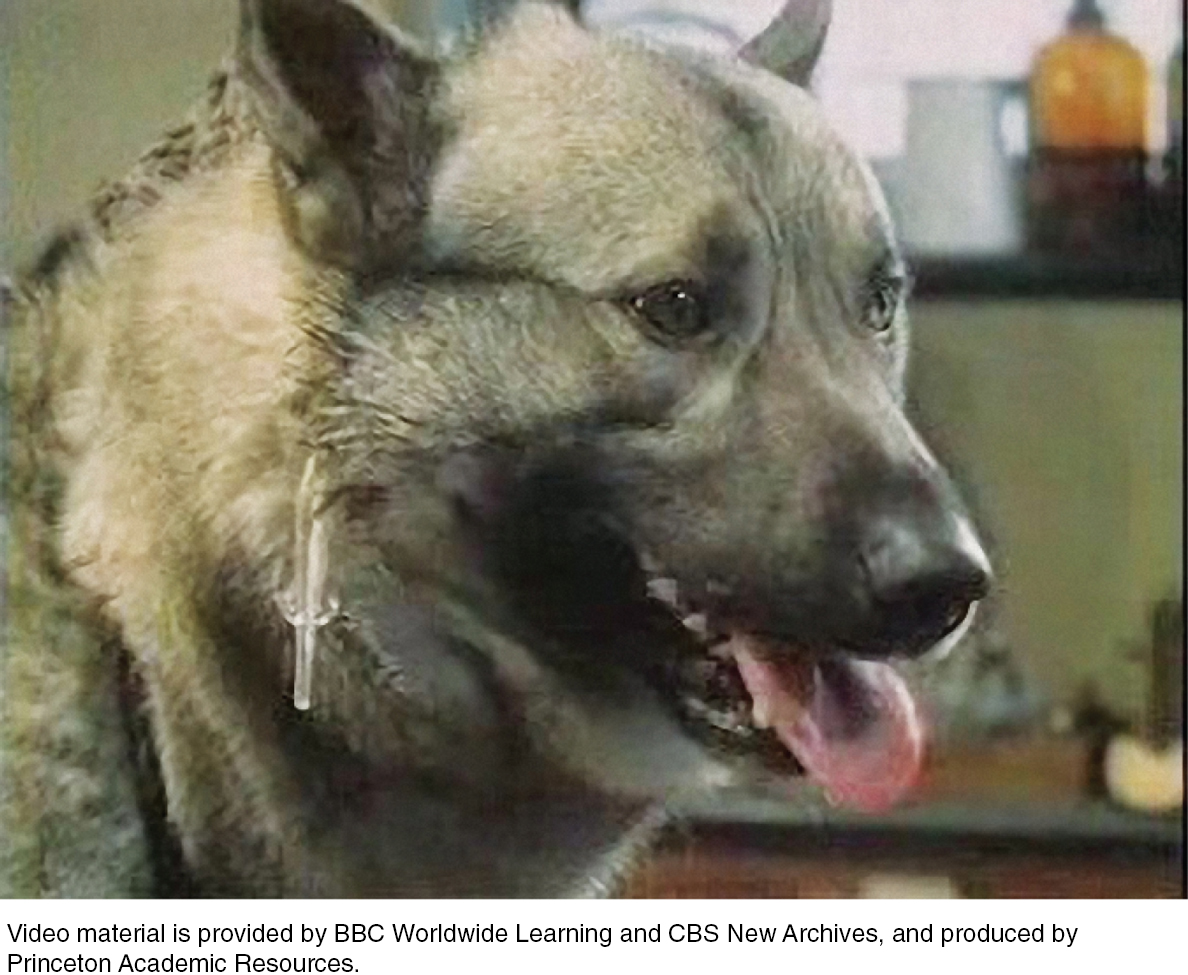
Why does Pavlov’s work remain so important? If he had merely taught us that old dogs can learn new tricks, his experiments would long ago have been forgotten. Why should we care that dogs can be conditioned to salivate at the sound of a tone? The importance lies first in this finding: Many other responses to many other stimuli can be classically conditioned in many other organisms—in fact, in every species tested, from earthworms to fish to dogs to monkeys to people (Schwartz, 1984). Thus, classical conditioning is one way that virtually all organisms learn to adapt to their environment.
Second, Pavlov showed us how a process such as learning can be studied objectively. He was proud that his methods involved virtually no subjective judgments or guesses about what went on in a dog’s mind. The salivary response is a behavior measurable in cubic centimeters of saliva. Pavlov’s success therefore suggested a scientific model for how the young discipline of psychology might proceed—
RETRIEVE IT
Question
In slasher movies, sexually arousing images of women are sometimes paired with violence against women. Based on classical conditioning principles, what might be an effect of this pairing?
APPLICATIONS OF CLASSICAL CONDITIONING
19-
In many areas of psychology, including consciousness, motivation, emotion, health, psychological disorders, and therapy, Pavlov’s principles are used to influence human health and well-
Former drug users often feel a craving when they are again in the drug-
using context— with people or in places they associate with previous highs. Thus, drug counselors advise their clients to steer clear of people and settings that may trigger these cravings (Siegel, 2005). Classical conditioning even works on the body’s disease-
fighting immune system. When a particular taste accompanies a drug that influences immune responses, the taste by itself may come to produce an immune response (Ader & Cohen, 1985).
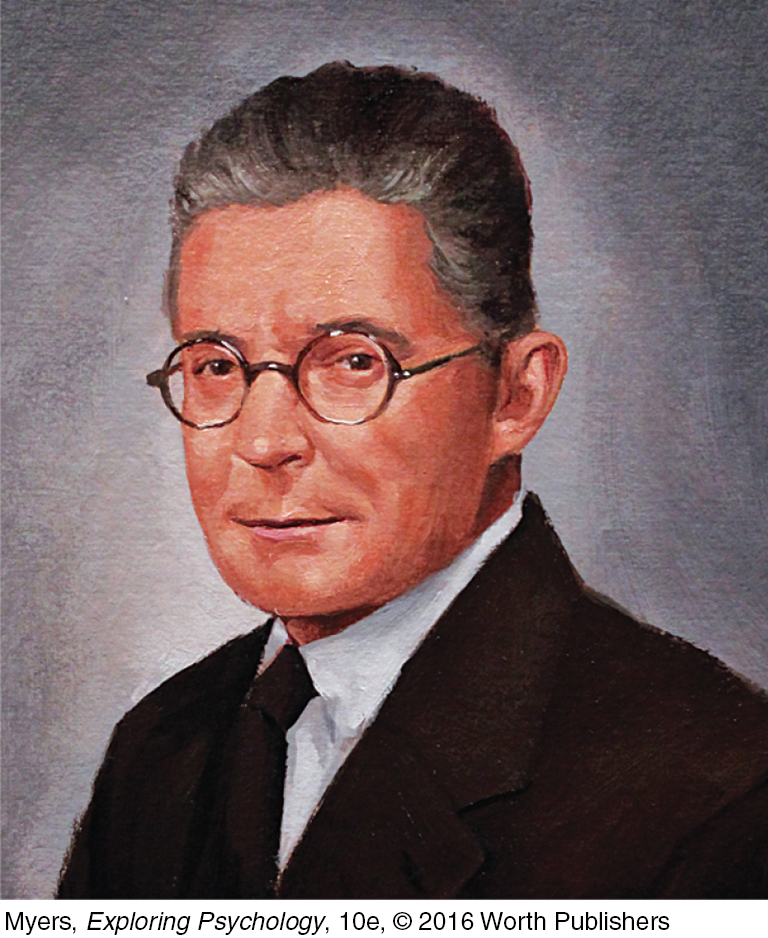
Pavlov’s work also provided a basis for Watson’s (1913) idea that human emotions and behaviors, though biologically influenced, are mainly a bundle of conditioned responses. Working with an 11-
For years, people wondered what became of Little Albert. Sleuthing by Russell Powell and his colleagues (2014) found a well-
People also wondered what became of Watson. After losing his Johns Hopkins professorship over an affair with Rayner (whom he later married), he joined an advertising agency as the company’s resident psychologist. There, he used his knowledge of associative learning to conceive many successful advertising campaigns, including one for Maxwell House that helped make the “coffee break” an American custom (Hunt, 1993).
 See LaunchPad's Video: Research Ethics for a helpful tutorial animation.
See LaunchPad's Video: Research Ethics for a helpful tutorial animation.
The treatment of Little Albert would be unacceptable by today’s ethical standards. Also, some psychologists had difficulty repeating Watson and Rayner’s findings with other children. Nevertheless, Little Albert’s learned fears led many psychologists to wonder whether each of us might be a walking warehouse of conditioned emotions. If so, might extinction procedures or even new conditioning help us change our unwanted responses to emotion-
One patient, who for 30 years had feared entering an elevator alone, did just that. Following his therapist’s advice, he forced himself to enter 20 elevators a day. Within 10 days, his fear had nearly vanished (Ellis & Becker, 1982). Other modules offer more examples of how psychologists use behavioral techniques to treat emotional disorders and promote personal growth.
RETRIEVE IT
Question
In Watson and Rayner's experiments, “Little Albert” learned to fear a white rat after repeatedly experiencing a loud noise as the rat was presented. In these experiments, what was the US? The UR? The NS? The CS? The CR?
